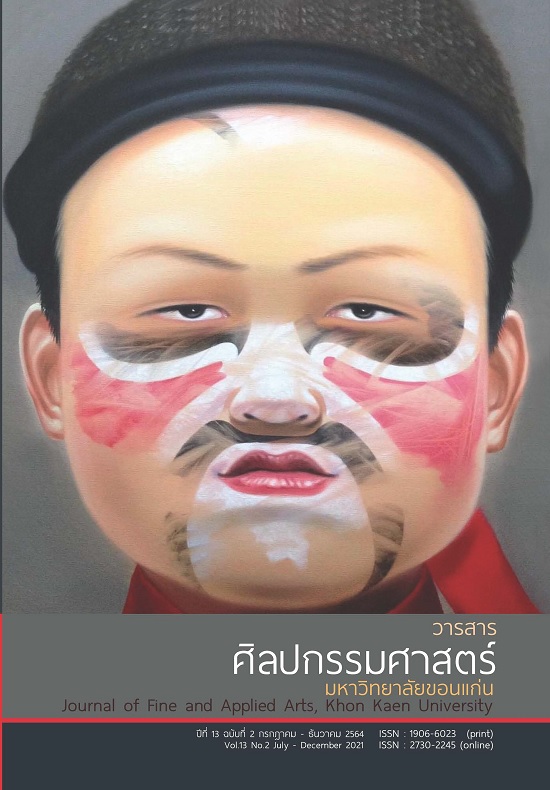Creative Performance : Ram Chui Chai Ramawatan
Main Article Content
Abstract
The purposes of this research were to: 1) study the history and components of Ram Chui Chai (a kind of Thai traditional dance), 2) analyze the components, principle and method in creating Ram Chui Chai Ramawatan, 3) create a performance of Ram Chui Chai Ramawatan. Data were collected from documents, interviews, observations of Thai dramatic arts experts and people concerned to use as information for the creation of the performance. Group conversations were also set up to check the correctness of the performance.
The results revealed that Ram Chui Chai was a name of both a song and a dance. The purpose of the dance was to celebrate self-admiration after transfiguration or being adorned. The components of Chui Chai song consisted of - 1) playing Plen Ok (stage entering song) and Pleng Rua. 2) 2 lyrics of Chui Chai song (3 stanzas each) and 2 lyrics of Mae Sri (2 stanzas each). After finishing each stanza of Chui Chai lyrics the pi (reeded wind instrument) would be played to imitate the words of the lyrics. Likewise after finishing Chui Chai songs the Pi Phat (wood xylophone) ensemble would play Chui Chai tune. 3) After finishing Mae Sri song, piphat ensemble would play Mae Sri tune. 4) Exit song (quick and bidding farewell songs). Ram Chui Chai could be classified into 3 types – 1) Full performance, 2) Deleted performance, 3) Chui Chai Phuang (without pi playing to imitate the sung words). The dance could also be divided according to types of performances into 4 group -1) Khon , 2) Lakhon, 3) Ram Chui Chai on special occasions, 4) Ram Chui Chai Burk Rong (a dance before the main performance). For the costumes, they could be either Yuan Khruang (fully dressed) or according to occasions. Musical instruments used were pi nai (reeded wind instrument) played to imitate words sung in the lyrics. Dancers needed to be skillful in Thai dramatic dance. Ram Chui Chai Ramawatan was a solo dance. The lyrics were composed from the history of Phra Ram (the hero in Ramayana). The tunes and dance movements were newly created according the Thai dramatic arts tradition. Ram Chui Chai Ramawatan movements were derived from the major movements of Pra Ram by adapting from the fighting movements and troop reviewing movements designed by the Fine Arts Department. The dance movements could be divided into 4 steps: step 1-entering the stage with Sot Soy movement together with pleng rua (a quick-rhythm song) and face coving gesture with one hand, step 2 – movements according to Chui Chai and Mae Sri songs, and step 3 - movements according to Bat Sakunee song. The costumes used were green with red long-sleeve Kruang Phra, Siraphon, and Chadayotchai (a crown). Musical instruments were those of hard wood xylophone ensemble. Chances of performances were to perform with Ramayana Khon, or on its own performance for the public. In addition, the researcher invented a new costume with an adaption of the traditional costume originally designed by the Fine Arts Department.
Article Details
Content and information in articles published in the Journal of Fine and Applied Arts of Khon Kaen University is regarded as the opinion and sole responsibility of the author(s) directly; therefore, editors are not obliged to agree to or share any responsibility with regard to the content and information that appears within these articles.
All articles, information, content, image, etc. that have been published in the Journal of Fine and Applied Arts of Khon Kaen University is the copyright of the Journal of Fine and Appllied Arts of Khon Kaen University. Any person or organization who wishes to distribute all or parts of the articles for further dissemination or other usage must first receive permission from the Journal of Fine and Applied Arts of Khon Kaen University before proceeding to do so.
References
กรมศิลปากร. (2551). ทะเบียนข้อมูล : วิพิธทัศนา ชุดระบำ รำ ฟ้อน เล่ม 3. กรุงเทพฯ : อมรินทร์พริ้นติ้ง แอนพับลิซซิ่ง.
กรมส่งเสริมวัฒนธรรม. (2562). โขน มรดกทางวัฒนธรรมที่จับต้องไม่ได้ของมนุษย์ชาติรายการแรกของประเทศไทย. กรุงเทพฯ : ชุมนุมสหกรณ์การเกษตรแห่งประเทศไทย.
ชวลิต สุนทรานนท์. [ม.ป.ป.]. ฉุยฉาย. กรุงเทพฯ : สำนักการสังคีต กรมศิลปากร.
ไพฑูรย์ เข้มแข็ง. (2537) จารีตการฝึกหัดและการแสดงโขนของตัวพระราม. วิทยานิพนธ์ปริญญาศิลปศาสตรมหาบัณฑิต สาขานาฏยศิลป์ไทย บัณฑิตวิทยาลัย จุฬาลงกรณ์มหาวิทยาลัย.
ไพโรจน์ ทองคำสุก. (2549). ศิริวัฒน์ ดิษยนันท์ ศิลปินแห่งชาติ ต้นแบบของศิลปินชั้นครู ผู้ถ่ายทอด และสร้างสรรค์นาฏศิลป์ไทย. กรุงเทพฯ : สำนักการสังคีต กรมศิลปากร.
ราชบัณฑิตยสถาน. (2556). พจนานุกรมฉบับราชบัณฑิตยสถาน พ.ศ. 2554. พิมพ์ครั้งที่ 2. กรุงเทพฯ : ราชบัณฑิตยสถาน.
ราศิยศ วงศ์ศิลปะกุล และศิริรัตน์ วุฐิสกุล. (2555). ดนตรี–นาฏศิลป์. กรุงเทพฯ : พัฒนาคุณภาพวิชาการ.
ศุภชัย จันทร์สุวรรณ์. (2559). ด้วยรักจากใจศิลปินในดวงใจ. กรุงเทพฯ : เนติกุลการพิมพ์.
สุรพล วิรุฬห์รักษ์. (2547). หลักการแสดงนาฏยศิลป์ปริทรรศน์. กรุงเทพฯ : จุฬาลงกรณ์มหาวิทยาลัย.


